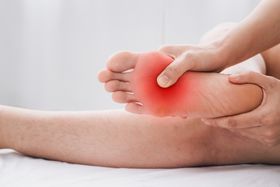Heel Spur vs. Plantar Fasciitis: Differences, Causes, and Treatments
Updated December 20, 2024.

There are a thousand and one conditions that cause foot pain, many of which have similar symptoms, such as restricted movement. Consequently, these conditions often reduce the quality of life of the individual.
Foot conditions must be managed appropriately to prevent them from worsening. Thus, it is important to correctly diagnose the cause of the symptoms and then choose a suitable treatment approach based on that.
Two common and similarly presenting foot conditions are plantar fasciitis and heel spurs. This guide shows their relation, differences, and how to treat them properly.
What Is Plantar Fasciitis?
Plantar fasciitis is the inflammation of the plantar fascia, the band of ligament that runs under the foot from the heel to the toes. When the ligament is inflamed, it causes sharp pain near the heel after a period of rest, discomfort when stretching the foot, and increased pain after activity.
What Is a Heel Spur?
A heel spur is a bony spur due to calcium deposits on the heel bone. While they are often painless, they can also cause significant heel pain. According to the American Association of Orthopaedic Surgeons (AAOS), 1 in 10 people has a heel spur, while only 1 in 20 individuals with heel spurs experience pain.
When heel spurs do cause pain, it is usually an intermittent and stabbing pain that is worse in the morning.
Can You Have Heel Spurs Without Plantar Fasciitis?
Heel spurs are the products of repeated trauma and damage to the foot muscles and heel ligaments. As a result, they can occur even without plantar fasciitis, and plantar fasciitis can also occur without heel spurs.
However, plantar fasciitis is often a secondary cause of heel spurs. Thus it is common to find that people with heel spurs also have plantar fasciitis.
Similarities and Differences Between Heel Spurs and Plantar Fasciitis
Perhaps the most significant difference between the two is that heel spurs may not cause pain, while plantar fasciitis usually always will. Additionally, the location of the pain is different. While pain from plantar fasciitis is typically present in the foot arch and the heel, pain due to heel spurs is localized to the heel bone. Also, while plantar fasciitis causes a sharp and burning sensation, heel spurs cause a stabbing pain.
Despite these differences, heel spurs and plantar fasciitis do present with a few similar symptoms, such as:
- Redness
- Swelling
- Tenderness
- Inflammation
They may also lead to pain and severe gait problems if left untreated.
Similar Risk Factors for Heel Spurs and Plantar Fasciitis
The same risk factors predisposing you to plantar fasciitis also increase your risk of developing heel spurs. Some of the factors which increase the chances of developing either plantar fasciitis or heel spurs are as follows:
- Tight calf muscles This places the strain on the heel and puts the plantar fascia under perpetual tension.
- Obesity or overweight The more an individual's weight, the more stress the foot has to bear and the higher chance of developing heel spurs or plantar fasciitis.
- Improper shoes Worn-out shoes, shoes without adequate support, and ill-fitting shoes can cause heel spurs and plantar fasciitis.
- Foot dynamics The presence of either flat feet or high arches can put more stress on different parts of your foot.
- Abnormal gait pattern
- Prolonged or sudden strain Prolonged repetitive activities requiring you to stand on your feet for a long time daily, or high-impact sporting activities like running, jumping, and hiking can all increase your chances of developing these conditions, as well as sudden changes in your physical activity levels without adjustment.
Can You Treat Heel Spurs and Plantar Fasciitis?
Once a diagnosis of heel spur or plantar fasciitis is made, it is best to ensure prompt treatment. Without that, the bony spurs will eat into the fat pads of the legs and, with plantar fasciitis, cause foot complications. These complications can further cause chronic ankle, knee, hip, and lower back pain.
Treatment of these conditions will usually involve the following methods:
- Rest and ice Rest and ice deal directly with the pain and inflammation but do not address the cause.
- Proper shoes Ensure you use shoes that fit properly, provide adequate comfort, and are suitable for the kind of activities you often perform.
- Exercises A combination of stretches and foot stabilizing and strengthening exercises can be incorporated when treating plantar fasciitis and heel spurs.
- Orthotic inserts Orthotic inserts are designed to provide more cushion to the heel and reduce the strain placed on the plantar fascia. You can purchase affordable and customized orthotic inserts from our online store.
- Surgery Surgical intervention is considered a last resort when pain persists without improvement for up to six months. It involves either the removal of a heel spur or the release of the plantar fascia.
» Ready to speed up your plantar fasciitis recovery? Get yourself a pair of custom orthotics and read our expert review








